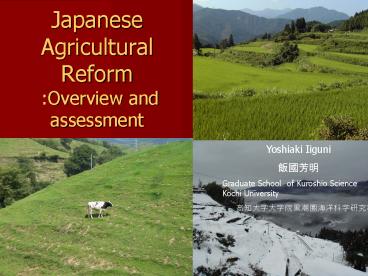Japanese Agricultural Reform :Overview and assessment - PowerPoint PPT Presentation
1 / 30
Title:
Japanese Agricultural Reform :Overview and assessment
Description:
outline the Japanese agriculture and the problems. overview upcoming agricultural ... Production value (Yen, billon) 0,426. main business farm house hold. 1,963 ... – PowerPoint PPT presentation
Number of Views:29
Avg rating:3.0/5.0
Title: Japanese Agricultural Reform :Overview and assessment
1
Japanese Agricultural Reform Overview and
assessment
Yoshiaki Iiguni ???? Graduate School of Kuroshio
Science Kochi University ?????????????????
2
Purpose of this report
- outline the Japanese agriculture and the problems
- overview upcoming agricultural reforms
- summarize the discussion on the reform
3
Japanese agricultural situation
4
(No Transcript)
5
Problem 1 The low level of food self-sufficiency
ratio
6
(No Transcript)
7
Problem 2 The size of farming (ha)
8
Rice
Business farm household
Semi-business farm household
Side-business farm household
Wheat
Wheat
Bean
Potato
Cereal
Vegetable
Fruits
Flower
Milk
Cattle
Pig
Fig. Production share of product by farm
household type
9
Problem 3 Aging of key agricultural workers
Job is main activity
10
Estimation of the number of key agricultural
workers
(10,000)
2000
2010
11
Problem 4 Expansion of abandoned land
12
Problem 5 Boarder Policy of Rice tariff-rate
quota (TRQ) system
Upper limit of mark up
Tariff (341yen/kg)
Mark up
Import price
Quantity
Import with Tariff
M.A with zero tariff
13
Introduction of direct payment in Japan (2007)
- Measures for Farm Management Stabilization (MFMS)
- Measures related to Rice Policy Reform (MRPR)
- Measures to Conserve and Improve Rural resources
(MCIR)
14
Purpose of measures
15
Measures for Farm Management Stabilization (MFMS)
- Direct Payment for Land-extensive farming (DPL)
- Measures for Mitigation of Revenue Fluctuation
(MMRF)
16
Measures for Farm Management Stabilization (MFMS)
Measures for Mitigation of Revenue Fluctuation
Direct Payment for Land-extensive farming
17
Eligible farmers
- Certified farmers as core-farmer
- gt 4ha (gt 10ha in Hokkaido)
- Village farming collective
- gt 20ha
18
Measures related to Rice Policy Reform (MRPR)
- Measures to Create Producing Areas (MCPA)
- Grant to create production area
- Grant for securing basis of rice farming income
- Grant for fixing a new system of adjusting the
supply and demand
19
Measures to Conserve and Improve Rural resources
(MCIR)
Farmers group
Direct payments to environmental farming
Direct payments to Common activities
Local community
20
Features of direct payment in Japan
21
Eligible farmers
Measures for Farm Management Stabilization (MFMS)
- Certified farmers as core-farmer
- gt 4ha (gt 10ha in Hokkaido)
- Village farming collective
- gt 20ha
22
Features of direct payment in Japan
23
Measures to Conserve and Improve Rural resources
(MCIR)
Farmers group
Direct payments to environmental farming
Direct payments to Common activities
Local community
24
Features of direct payment in Japan
25
Direct Payment for Land-extensive farming
.
26
The number of application and the area of Direct
Payment for Land extensive farming
(F.Y. 2007)
27
The number of application of Direct Payment in
MCIR
(F.Y. 2007)
28
Discussion on the reform
Self sufficiency ratio as a political object
affirmative
Critical group
The current reform
Range of targeted farmers
restrictive
Non-restrictive
Big Bang
negative
Source Y. Tashiro
29
A critique by Professor Kajii
30
Concluding remarks
- It should be appreciated that Japanese government
introduced original direct payments based on its
agricultural structure in the reform. The direct
payments are not just duplicated measures of
European countries. - But, the measures are government-led, though
the government emphases on the importance of
market-led measures. - The government led measures might not be able
to achieve efficient resource allocation (see.
Kajii). - We should improve the measures, and design more
market-oriented programs.































